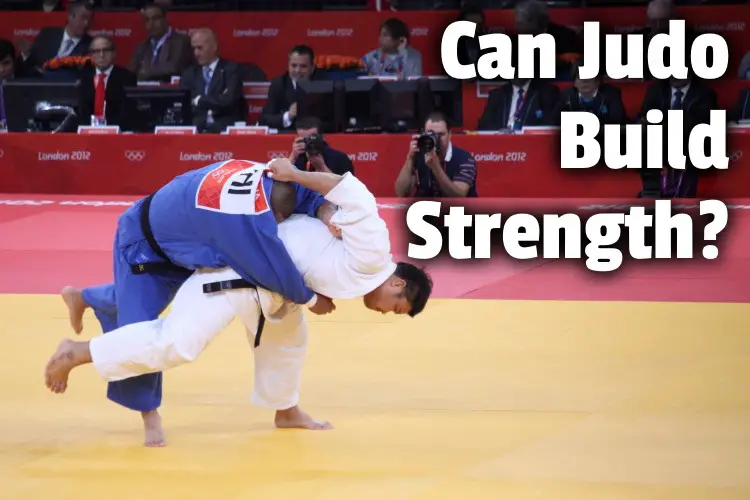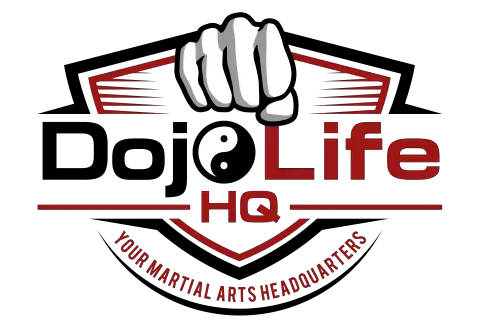
Judo is about using leverage to defend oneself and using your opponent’s energy against them, even against someone stronger. But, can Judo build strength?
Here’s what I know from training it a little bit:
Judo does build strength and muscles as it involves being able to grip, pull, and throw opponents who could be stronger, bigger, and fitter than oneself. Virtually all the major muscles of the body are engaged, and it is incredibly physically demanding.
Of course, it all looks effortless, but it takes strength and smarts to be a good Judoka. It’s a sport that’s tough on the body.
I have been involved in martial arts on and off almost my whole life. In this article, we’ll look at whether it’s good for fitness, the muscles affected when you use your Judo skills, and how important it is to be fit before you start training in Judo.
Let the fun begin.
This morning @stgejs, Sarah, our Judo teacher demonstrated some Judo moves. Judo is great for fitness and strength. Junior School girls can sign up if they’d like to join the club next term #welovejudo pic.twitter.com/Sf0MCcGY8o
— St George’s JS (@stgejs) December 9, 2019
Is Judo good for fitness?
Judo is good for fitness because almost all major muscle groups are engaged during practice. It employs all the key facets of physical fitness, which include muscular strength and endurance, cardiovascular training, flexibility, and body fat composition.
During the practice of Judo, you’ll have to repeat many techniques over and over again. That alone is awesome cardio.
Even if one were to leave other forms of exercise for a while, the practice of Judo is physically demanding and is a way of keeping fit.
Consider that you’ll have to grip, pull, and throw someone about your size (who doesn’t want to be gripped, pulled, or thrown), and you’re expected to control how they fall because the intention is not to harm them. There are times you’ll try and choke or strangle them.
Not exactly a walk in the park, right?
And, when you are thrown (and you’ll be thrown countless times), you’re expected to land gracefully so that you don’t injure yourself.
The application of the techniques you’ll learn would require you to exert yourself a lot. You’ll sweat a lot, and you’ll be burning lots of calories. In fact, an average Judo session burns about 360 calories per hour.
Apart from the core Judo skills itself, which would make you fit, there are also associated warm-up drills you’ll be expected to do at the start of each class.
But is Judo something you can teach yourself?
In a recent article of mine, I showed why the answer is “yes” and I also offered actionable, cost-effective strategies that’ll help you.
Just click the link to read it on my site.
2 weeks down. 2 to go.
My knees hate me but I’m definitely getting stronger. Still can’t do a decent push up to save my life though. pic.twitter.com/Oi81wny9FW— Lisa McConville (@auldgrumpytits) December 1, 2020
What muscles does Judo work?
Judo works all the primary muscles, with special emphasis on the “core muscles”: the muscles in the belly, the mid and lower back, and partly those of the neck, shoulders, and hips.
But to be specific, major core muscles include:
- Pelvic floor muscles
- Transversus abdominis
- Multifidus
- Internal and external obliques
- Rectus abdominis
- Erector spinae (sacrospinalis)
- The longissimus thoracis
- The diaphragm
Minor core muscles include the latissimus dorsi, gluteus maximus, and trapezius.
Judo was designed to utilize a considerable chunk of the body when one is engaged in it.
So, in addition to the core muscles, even the muscles of your arms, legs, and back are being worked when you do Judo.
Consider that in order to pull someone effectively and throw them, one’s posture must be good, and that’s helped by the legs and back.
The simple act of gripping and pulling works the muscles of the arms.
On a light note, to have a sense of the muscles that Judo works on, pay attention to how you’ll feel the first week or two after you’ve started your Judo training.
You’ll probably feel aches all over.
Have just been flicking through photos, this is my youngest Amigo (brown hair!) and the throw that won her the British Championships in 2019. Covid put a stop to stuff after that! So glad she is now back on the mat and training again 🥋#judo #strongirl #proudmum #hardasnails pic.twitter.com/Njv3ofdIOj
— Kerry H (Kez) (@MrsProperLike) April 15, 2021
Is Judo hard on the body?
Judo can be hard on the body as it often involves throwing opponents to the ground repeatedly. This can lead to injury or strain, especially when starting a Judo practice if one lands in an awkward manner.
Judo is physically demanding. It involves being thrown, slammed, choked, and hyperextended.
You bet it’s got to be tough on the body.
It’ll take some time before you’ll get used to being smashed to the ground, being swept off one’s feet, arm locks, and chokeholds. These are all tough on the body.
The first few weeks of training may be particularly hard on you. (Not that subsequent weeks would be a walk in the park).
Why?
You may get thrown when you haven’t really mastered the art of Ukemi. It’s the art of receiving a fall gracefully. This is a key part of Judo that helps reduce the possibility of getting injured.
Even when you’re the one smashing someone to the ground, you’re not immune from the heat.
Knee and shoulder injuries, broken bones, nerve injuries from too much gripping, osteoarthritis, cauliflower ear are a few of the possible “side effects” of Judo.
Of course, not everybody experiences these. After all, our bodies differ.
Judo is hard on the body. That’s the honest truth. But do you think a Judoka can beat up a Karateka? In a recent article of mine, I shared why a Karateka would win.
Just click the link to read it on my site.
Boston judo building muscle. We love judo we love strong muscles @Dollamur @Martidamus #futureolympians pic.twitter.com/YEx53bmuKk
— Andrea Muccini (@andreamuccini1) May 17, 2016
What sort of training is required for Judo?
No training is required prior to starting Judo, but Judo classes will include training in muscle strengthening exercises, grip training, endurance training, and recovery and prevention strategies, in addition to the core Judo techniques.
The specific instruments used and the forms of the training may differ slightly from dojo to dojo but in general may include body weight, straps, machines, bands, ropes, medicine balls, stability balls…
Judo is largely a game of throws. These are usually executed so swiftly that one may miss the mechanics.
Having stronger muscles helps with being able to employ the techniques well.
Consider that the typical move involves gripping an opponent’s Gi, pulling them, and then throwing them.
Or suppose you’ve got the fellow down, and you’re applying a Kimura on them, the stronger your muscles, the easier it is to execute. A kimura is a form of arm lock.
And before any throw, you must grip the opponent’s Gi. There are several exercises to help you grip better. If you can’t grip them, you can’t throw them.
Muscle-strengthening exercises make you stronger, help you with balance, and improves your ability for Kumi kata, one of the standard Judo grips.
Judo is highly demanding, so you need endurance training too.
You’ll need cardio equipment. You’ll do a lot of running, aerobic and anaerobic exercises, which help with Uchi komi (repeated practice).
Recovery and prevention training relates to warmups and stretching, so you’ll be flexible and resilient.
These are often the first set of exercises and the last–they’re used to ease into the core training and wrap things up.
Judo yesterday:
Kimura from top, ways to break grip and finish
Rnc caught from scrambles
Ankle lock from single leg
Ol faithful*
D’arce and variations, seated katagatame, ways to squeeze
Scarf hold: Americana and straight armbar
Butterfly and scissor Sweeps
Great day
— Othr DeMepsche☦️🌲🥋 (@DeMepsche) February 21, 2020
What martial art is best for building muscles?
Muay Thai is the best martial art for building muscles. The training has an intensity such that one loses a lot of fat and becomes very muscular. This is one of the reasons why many MMA fighters train in Muay Thai.
As a martial artist, looking like a bodybuilder is the last thing you need. And having a body like Arnold Schwarzenegger’s would limit you as a martial artist.
That mass would limit your speed. So, the goal is to be lean, mean, and fast.
Muay Thai (MT) is great for this. MT fighters have some of the best muscular bodies, which reflect power. It’s also attractive.
But, it’s the result of a lot of work. In fact, the training sessions are so intense, they’re not for the faint-hearted. On average, you’ll lose between 600 to 1000 calories per training session!
Muay Thai practitioners are some of the toughest martial artists on earth.
They are trained to take the heat! I’m not kidding. That’s why being muscular comes with the territory.
You’ll punch, kick, clinch, use your knees, your elbows…Your muscles are being given intense drills from the core MT moves and exercises such as light weight-lifting (such as deadlifts), skipping rope, running, sprinting, pull-ups, box-jumps, pistol squats, burpees…I told you it’s intense.
No matter the martial art you eventually decide on, it’s important to note that you’d need to add a high protein diet and plenty of rest to get the best result for muscle gain.
I’ve got a question for you. What do you think would happen if a Judoka were to challenge a Krav Maga practitioner?
Check out a recent article of mine where I showed that the latter would probably come out tops if self-defense is what’s at stake.
Just click the link to read it on my site.
Conclusion
We learned that Judo is not as effortless as it seems. That, it’s, in fact, physically demanding and hard on the body.
We looked at whether Judo is good for fitness, the muscles that are engaged when you practice it. Yes, it is good for fitness. And, most of the muscles of the body are engaged, especially the core muscles.
Then we looked at why Judo is hard on the body. You’ll be slammed, choked, and hyperextended. Yeah, it’s hard on the body.
Finally, we looked at the kind of training one would need to engage in it. And, we wrapped things up by looking at the best martial art for building muscle. And Judo is great for building strength in both kids and adults.
Photo which requires attribution:
Olympic Judo London 2012 (23 of 98) by Martin Hesketh is licensed under CC2.0 and was cropped with a text overlay added.
